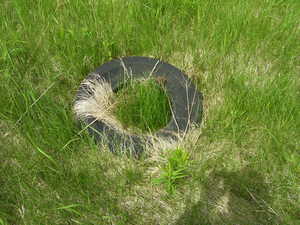 If you've ever driven on a Missouri highway, you've probably seen "alligators" by the side of the road. And no, we're not talking about the alligators you might find in a Florida swamp. A roadside alligator is tire debris, often referred to as a "gator skin" by the trucking industry, and commonly found along any stretch of roadway, from St. Louis to Springfield and from Kansas City to Cape Girardeau. These roadside alligators can cause trucking accidents and truck related traffic accidents: in fact, our Missouri truck accident lawyers have seen many accident cases involving tire debris. Trucking accidents can be caused by loss of control due to a tire blow out. Other vehicles can be struck by tire debris. When drivers try to avoid debris, or run it over, additional collisions can occur.
If you've ever driven on a Missouri highway, you've probably seen "alligators" by the side of the road. And no, we're not talking about the alligators you might find in a Florida swamp. A roadside alligator is tire debris, often referred to as a "gator skin" by the trucking industry, and commonly found along any stretch of roadway, from St. Louis to Springfield and from Kansas City to Cape Girardeau. These roadside alligators can cause trucking accidents and truck related traffic accidents: in fact, our Missouri truck accident lawyers have seen many accident cases involving tire debris. Trucking accidents can be caused by loss of control due to a tire blow out. Other vehicles can be struck by tire debris. When drivers try to avoid debris, or run it over, additional collisions can occur.
A Retread Study with Missouri Trucking Accident Implications
A common belief is that gator skins come from retread tires. A retread is a tire manufactured by bonding new tread onto a used (but still in excellent condition) tire casing. The University of Michigan Transportation Research Institute (UMTRI) decided to find out if these traffic hazards are indeed the product of retread tires.
During the summer of 2007, UMTRI begun a two year nationwide study. They collected tons of tire debris and tire casings from interstates and truck stops near major trucking routes. Then, the tire materials were analyzed to determine if the debris and casings came from new tires or from retreads. UMTRI also attempted to pinpoint what exactly caused the tire failure. Part of trucking accident law (and part of UMTRI's mission) is to determine the cause of trucking accidents, and make efforts reduce the number of truck related damages, injuries and fatalities.
The Study Results
The study showed that 60% of the tire casings tested, when the origin could be determined, came from new tires. The study also showed that only 21% of the tire debris came from new tires, meaning 79% of tire debris came from retreads.
Perhaps more importantly, the study determined the primary causes of tire rupture of failure. They found the following causes, In order of prevalence:
• 38% of the fragments came from a roadside hazard, such a nail puncture or hitting a curb.
• 36% of the casings came from a roadside hazard.
• 32% of the tire casings came from operational or maintenance issues.
• 30% of the fragments came from excessive heat.
• Fewer than 15% of failure in both casings and fragments actually came from the retread process.
What the Study Means to Missouri Drivers
The majority of commercial truck tire failures do not happen because of tire manufacturing, the retread process, or process deficiencies. In fact, the numbers actually reveal that improper maintenance, underinflated tires, and improper safety inspections are actually the leading causes of tire failure and tire debris.
It's our hope that the trucking industry will continue to implement stronger quality control procedures, which can help reduce trucking accidents resulting from tire debris and tire blowouts. Drivers of passenger vehicles should also make sure their tires are properly maintained: UMTRI discovered that 20% of debris collected came from cars and light trucks.
Injuries from trucking accidents can be very serious and require extensive medical treatment. If you or a loved one has been injured in a trucking accident, call 1-888-777-AUTO to schedule a free consultation with one of our Missouri truck accident lawyers.
Attorney meetings by appointment only
